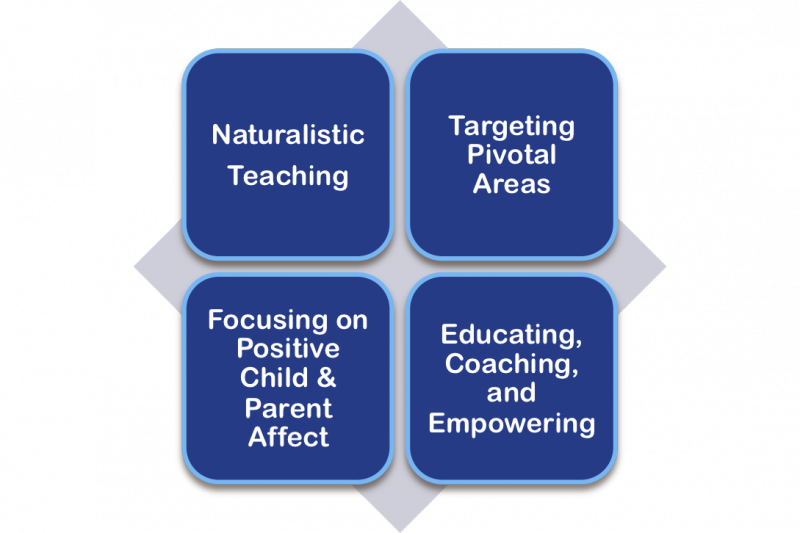Key Features and Guiding Principles of PRT
 Select a link below to read more:
Select a link below to read more:
Naturalistic Teaching
Use naturalistic teaching to improve developmentally appropriate skills.
When the motivational components of PRT are combined, children are taught through social interactions that are as close as possible to more typical learning experiences. Parents and practitioners target pivotal areas and specific developmentally appropriate skills:
- in naturally occurring contexts (e.g., taking turns during play, during daily routines in “everyday settings” at home and in the community)
- with natural stimuli (for example, favorite toys or activities, more typical and varied instructional antecedents, varied learning opportunities or tasks)
- with natural change agents (For example, parents, siblings, respite workers, center-based educators, and practitioners)
- with natural contingencies (For example, loose teaching contingencies based on reinforcing attempts; using natural/direct reinforcers; contingent recasts of child communication, Koegel & Koegel, 2012.)
Skills or behaviors selected are developmentally appropriate and individualized, and developed in collaboration with parents and team members.
What specific behaviors or skills are targeted in PRT for infants and toddlers?
|
|
|
For more information related to naturalistic teaching, see the Naturalistic Intervention learning module and Allen and Cowan’s (2008) chapter on naturalistic teaching procedures.
Target Pivotal Areas
Target pivotal areas, particularly the toddler’s motivation to learn and engage.
Pivotal areas are suspected, through research, to produce a wider range of changes (e.g., collateral effects) compared to teaching many skills in isolation, one right after another. Also referred to as pivotal responses, pivotal behaviors, and/or behavioral cusps, pivotal areas cause a “ripple effect,” whereby a direct improvement in a pivotal area can lead to indirect improvements in many other skills.
Focus on positive child and parent affect
PRT components can improve toddler happiness, interest, enthusiasm, and overall
behavior.
Learning and interaction should be fun! These improvements help make PRT an acceptable and feasible intervention for parents and practitioners to implement. By implementing PRT motivational components, toddlers are learning and they are enjoying social interaction and intervention more often. Likewise, active parent involvement in interventions improves parent affect and confidence, and decreases parent stress (Brookman-Frazee, 2004). Positive affect is “contagious” in that happy and engaged toddlers can lead to happy and engaged parents, which in turn increases and maintains the toddler’s positive affect, and so on. It is important that sessions are conducted in a way that is fun and interactive for both toddlers and parents. PRT motivational components contribute to improving child and parent affect.
Educate, coack, and empower parents, family members, and practitioners or teachers
Significant individuals in the toddler’s life, particularly parents, are the primary
individuals carrying out PRT throughout the toddler’s day in natural, everyday
environments.
Educating and coaching parents is interactive in PRT, and involves a combination of didactic instruction, modeling by the clinician, practice by the parents, and immediate “live” feedback from the parent educator. This means that, during parent education sessions, both parents and practitioners are working together in a collaborative manner with a toddler. Variations of this PRT parent education model exist (Steiner, Koegel, Keogel, & Ence, 2012). For instance, group parent training formats and self-directed DVD parent training programs in PRT can also be used successfully. However, it is essential that parents and practitioners actively practice the techniques while receiving on-going feedback.
Emphasizing collaboration and parent empowerment, PRT parent education sessions incorporate parental expertise in setting up their toddler’s program (e.g., planning the toddler’s goals/objectives) as well as implementing the intervention. For example, parents help to pick out toys or what words to teach to the toddler during play. Many parents can obtain a high degree of confidence, reduced stress, and high levels of treatment fidelity (i.e., they can implement PRT well) through this approach. This parent education model is a cornerstone to PRT, but can apply to various natural change agents, including early childhood educators, practitioners, respite workers, siblings, and relatives.
 Naturalistic Teaching
Naturalistic Teaching